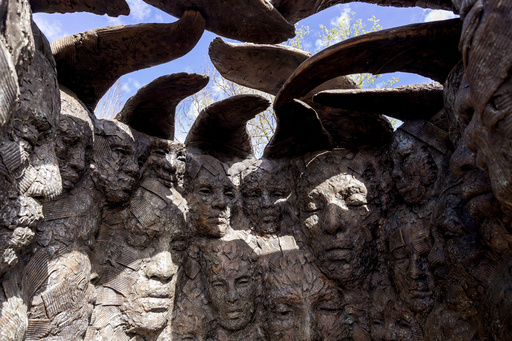MONTGOMERY, Ala. (AP) — Visitors to the Freedom Monument Sculpture Park wind a serpentine path past art pieces depicting the lives of enslaved people in America and historic exhibits, including two cabins where the enslaved lived, before arriving at a towering monument.
Stretching nearly four stories into the sky, the National Monument to Freedom honors the millions of people who endured the brutality of slavery. The monument is inscribed with 122,000 surnames that formerly enslaved people chose for themselves, as documented in the 1870 Census, after being emancipated at the Civil War’s end.
The sculpture park is the third site created by the Equal Justice Initiative in Montgomery, Ala., which is dedicated to taking an unflinching look at the country’s history of slavery, racism and discriminatory policing. The first two sites — the National Memorial for Peace and Justice, a memorial to people slain in racial terror killings; and The Legacy Museum: From Enslavement to Mass Incarceration — opened in 2018.
The sculpture park, which opens March 27, weaves art installations, historic artifacts and personal narratives to explore the history of slavery in America and honor the millions of people who endured its brutality.
Bryan Stevenson, the founder of Equal Justice Initiative, said after opening the first two sites that he felt there was more to do. Most plantation tourist attractions, he said, are centered around the lives of the family that did the enslaving. His goal was a place for visitors to have a “really honest experience with the history of slavery.”
“I do see it as a truth-telling space, a place where we can confront parts of our history and paths that are not usually taught,” he said. But he also believes it is ultimately a “hopeful place.”
“If people found a way to create family and future, despite the horrors of that institution, then we can do something comparable in our day to create a future that is less burdened by these histories than I think we’ve been,” Stevenson said.
The 17-acre site is nestled between the twisting banks of the muddy waters of the Alabama River and railroad tracks — the two transportation mechanisms used to bring people to the city’s slave markets in the 1800s. Visitors will be able to arrive by boat, essentially tracing the same path taken to deliver the stolen and trafficked people.
The park is opening as some politicians, including in the Deep South, try to put parameters on how race and history are taught in classrooms and in workforce training sessions. Stevenson says such push-back has always accompanied progress.
“I see this as a kind of a desperate act to hold on to the silence and the status quo and the burden of bigotry which we’ve coped with for so long. And I just don’t believe it will succeed because the truth is powerful,” Stevenson said.
The sculpture park includes major pieces from artists including Simone Leigh. Leigh’s Brick House, a 16-foot-tall bronze bust of a Black woman, sits as a formidable presence of strength at the entrance to the garden.
In a piece titled Mama, I hurt my hand, by Kwame Akoto-Bamfo, a child dragging a bag of cotton reaches out to show his injured hand to his mother, who balances a basket of cotton and an infant strapped to her back. Near them, a weary man with scarred skin and a splinted leg, sits in exhaustion.
The exhibits include two 170-year-old cabins that housed enslaved families on a cotton plantation, a whipping post, chains used to hold trafficked people and replicas of a transport box car and slave-holding pen. Interwoven between the exhibits are first-person accounts by enslaved people and formerly enslaved people about their lives.
Alison Saar, a Los Angeles-based sculptor, has a piece featured in the garden that “addresses escaped slaves and their ability to survive and thrive on their own,” she said.
“I find the whole thing incredible and more necessary than ever,” Saar said. Park visitors will come upon sculptures that convey “not only the horrors of being enslaved but the really beautiful stories and glory of people that somehow escaped that and created a life of their own.”
The park’s centerpiece is the National Monument to Freedom, which bears names taken from the 1870 Census in which formerly enslaved people claimed surnames.
Visitors can walk up, find their family name and touch it while seeing their own faces reflected in the polished granite — an experience Stevenson himself went through recently as more of the names were inscribed in the stone.
“I came and I saw my name, and I was surprised by how impacted I was by that, even though I’ve been planning for two years,” he said.
EJI is a legal advocacy organization perhaps best known for its work freeing wrongly convicted death row inmates — the subject of the 2019 movie starring Michael B. Jordan and Jamie Foxx, based on Stevenson bestselling book “Just Mercy.”
The organization years ago erected the first historical markers in downtown Montgomery to mark the sites of slave markets, as well as lynching sites across the South.
Stevenson said truth and confronting history is the key for America to move forward, likening it to an alcoholic who must acknowledge the harm created by his abuse in order to move forward.
“I think there’s something better waiting for us. I think there’s something that feels more like freedom, more like equality, more like justice. But I don’t think we’ll get there if we don’t tear down the barriers and the burdens that have been created by our silence about history,” Stevenson said.
____
Race & Ethnicity Editor Aaron Morrison in New York contributed.
